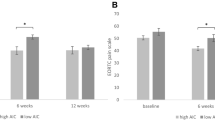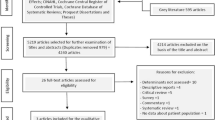Abstract
Background
Pain is a common symptom in patients undergoing cancer treatment. Despite recommendations for the stronger integration of complementary and integrative health (CIH) in cancer pain management, little is known about the individual experience of using this approach for cancer pain, particularly in certain populations such as African Americans.
Objective
This study aimed to describe the experiences of using CIH for pain in African American and White patients with cancer undergoing cancer treatments.
Methods
A secondary analysis of qualitative descriptive data from a subsample of patients with cancer in a parent study of their illness concerns was employed. Atlas.ti 8.0 was used for data management and qualitative analysis. Counts of participant-endorsed themes were tabulated to discern differences in themes by group.
Results
Of 32 participants (16 African American, 16 White), 22 reported CIH usage for cancer pain management, with equal distribution between groups (11 each). Three themes emerged: Approach to, Reasons for, and Barriers to CIH Use. Psychological approaches were most common (n = 15). Nutritional, physical, and combination approaches were less common and more often employed by White participants. Reasons for CIH use were to reduce opioid consumption or for an opioid adjuvant. Personal limitations and access issues contributed to Barriers to CIH use.
Conclusions
Both African American and White patients used CIH for pain management while undergoing cancer treatments. However, some preferential differences in CIH approaches by race surfaced. Further research into these differences may uncover new ways of addressing disparities in cancer pain management with CIH.
Similar content being viewed by others
Data availability
Available upon request.
Code availability
Available upon request.
References
van de Beuken-van Everdingen MHJ, Hochstenbach LMJ, Joosten EAJ, Tjan-Heijnen VCG, Janssen DJA (2016) Update on prevalence of pain in patients with cancer: systematic review and meta-analysis. J Pain Symptom Manage 51:1070–1090. https://doi.org/10.1016/j.jpainsymman.2015.12.340
Paice J, Portenoy R, Lacchetti C et al (2016) Management of chronic pain in survivors of adult cancers: American Society of Clinical Oncology clinical practice guideline. J Clin Oncol 34:3325–3345. https://doi.org/10.1200/JCO.2016.68.5206
Liou KT, Trevino KM, Meghani SH et al (2021) Fear of analgesic side effects predicts preference for acupuncture: a cross-sectional study of cancer patients with pain in the USA. Support Care Cancer. https://doi.org/10.1007/s00520-020-05504-y
Belcher SM, Watkins Bruner D, Hofmeister CC, Kweon J, Meghani SH, Yeager KA (2020) Characterizing pain experiences: African American patients with multiple myeloma taking around-the-clock opioids. Clin J Oncol Nurs 24:538–546. https://doi.org/10.1188/20.CJON.538-546
Mercadante S, Adile C, Tirelli W, Ferrera P, Penco I, Casuccio A (2020) Barriers and adherence to pain management in advanced cancer patients. Pain Pract 21:388–393. https://doi.org/10.1111/papr.12965
Meghani SH, Wool J, Davis J et al (2020) When patients take charge of opioids: self-management concerns and practices among cancer outpatients in the context of opioid crisis. J Pain Symptom Manage 59:618–625. https://doi.org/10.1016/j.jpainsymman.2019.10.029
Wiffen PJ, Wee B, Derry S, Bell RF, Moore RA (2017) Opioids for cancer pain: an overview of Cochrane reviews Cochrane Database Syst Rev 7: Art. No.: CD012592. doi: https://doi.org/10.1002/14651858.CD012592.pub2.
Keene MR, Heslop IM, Sabesan SS, Glass BD (2019) Complementary and alternative medicine use in cancer: a systematic review. Complement Ther Clin Pract 35:33–47
Sanford NN, Sher DJ, Ahn C, Aizer AA, Mahal BA (2019) Prevalence and nondisclosure of complementary and alternative medicine use in patients with cancer and cancer survivors in the United States JAMA. Oncol 5:735–737. https://doi.org/10.1001/jamaoncol.2019.0349
Judson PL, Abdallah R, Xiong Y, Ebbert J, Lancaster JM (2017) Complementary and alternative medicine use in individuals presenting for care at a comprehensive cancer center. Integr Cancer Ther 16:96–103. https://doi.org/10.1177/1534735416660384
Horneber M, Bueschel G, Dennert G, Less D, Ritter E, Zwahlen M (2012) How many cancer patients use complementary and alternative medicine: a systematic review and metaanalysis. Integr Cancer Ther 11:187–203. https://doi.org/10.1177/1534735411423920
Alsharif F (2021) Discovering the use of complementary and alternative medicine in oncology patients: a systematic literature review. Evid Based Complement Alternat Med 2021: Article ID 6619243. https://doi.org/10.1155/2021/6619243
Liou KT, Hung TKW, Meghani SH et al (2019) What if acupuncture were covered by insurance for pain management? A cross-sectional study of cancer patients at one academic center and 11 community hospitals. Pain Med 20(10):2060–2068. https://doi.org/10.1093/pm/pnz087
Wu HJ, Tai CJ, Tai CJ, Chien LY (2019) Symptom severity, symptom interference and use of complementary and alternative medicine among survivors of colorectal and breast cancer after curative treatment in Taiwan. Eur J Cancer Care (Engl) 28(1):e12925. https://doi.org/10.1111/ecc.12925
National Center for Complementary and Integrative Health (2021) Complementary, alternative, or integrative health: what’s in a name? Retrieved from https://www.nccih.nih.gov/health/complementary-alternative-or-integrative-health-whats-in-a-name
National Center for Complementary and Integrative Health. NCCIH strategic plan FY 2021–2025: mapping the pathway to research on whole person health. Retrieved from https://nccih.nih.gov/about/nccih-strategic-plan-2021-2025.
National Comprehensive Cancer Network (2021) NCCN clinical practice guidelines in oncology: adult cancer pain. V.2.2021. Retrieved from https://www.nccn.org/professionals/physician_gls/pdf/pain.pdf
Ng JY, Sharma AE (2021) Guidelines for cancer-related pain: a systematic review of complementary and alternative medicine recommendations. Pain Pract 21:454–467. https://doi.org/10.1111/papr.12964
Meghani SM, Levoy K, Magan KC, Starr LT, Yocavitch L, Barg FK (2021) “I’m dealing with that”: illness concerns of African American and White cancer patients while undergoing active cancer treatments. Am J Hosp Palliat Med 38:830–841. https://doi.org/10.1177/1049909120969121
Sandelowski M (2000) Whatever happened to qualitative description? Res Nurs Health 23:334–340
Sandelowski M (2010) What’s in a name? Qualitative description revisited. Res Nurs Health 33:77–84
Sandelowski M (2001) Real qualitative researchers do not count: the use of numbers in qualitative research. Res Nurs Health 24(3):230–240. https://doi.org/10.1002/nur.1025
Albabtain H, Alwhaibi M, Alburaikan K, Asiri Y (2018) Quality of life and complementary and alternative medicine use among women with breast cancer. Saudi Pharm J 26(3):416–421. https://doi.org/10.1016/j.jsps.2017.12.020
Jones D, Cohen L, Rieber AG (2018) Complementary and alternative medicine use in minority and medically underserved oncology patients: assessment and implication. Integr Cancer Ther 17(2):371–379. https://doi.org/10.1177/1534735417735892
Goldstein JN, Ibrahim SA, Frankel ES, Mao JJ (2015) Race, pain, and beliefs associated with interest in complementary and alternative medicine among inner city veterans. Pain Med 16:1467–1474
Ludwick A, Corey K, Meghani S (2020) Racial and socioeconomic factors associated with the use of complementary and alternative modalities for pain in cancer outpatients: an integrative review. Pain Manag Nurs 21:142–150. https://doi.org/10.1016/j.pmn.2019.08.005
Fitzsimmons AG, Dahlke DV, Bergeron CD et al (2019) Impact of complementary and alternative medicine offerings on cancer patients’ emotional health and ability to self-manage health conditions. Complement Ther Med 43:102–108. https://doi.org/10.1016/j.ctim.2019.01.011
Bao T, Li Q, DeRito JL, Seluzicki C, Im EO, Mao J (2018) Barriers to acupuncture use among breast cancer survivors: a cross-sectional analysis. Integr Cancer Ther 17(3):854–859. https://doi.org/10.1177/1534735418754309
Alqahtani MMJ, Holmes T, AL-Rammah, TYM et al (2018) Are we meeting cancer patient needs? Complementary and alternative medicine use among Saudi cancer patients: a qualitative study of patients and healthcare professionals’ views. Eur J Integr Med 24:54-60. https://doi.org/10.1016/j.eujim.2018.11.002
Hansra DM, McIntyre K, Ramdial J et al (2018) Evaluation of how integrative oncology services are valued between hematology/oncology patients and hematologists/oncologists at a tertiary care center. Evid Based Complement Alternat Med 2018: Article ID 8081018. https://doi.org/10.1155/2018/8081018
Leppin AL, Fernandez C, Tilburt JC (2016) Missed opportunities: a mixed-methods analysis of CAM discussions and practices in the management of pain in oncology. J Pain Symptom Manag 52(5):719–726. https://doi.org/10.1016/j.jpainsymman.2016.05.025
Balneaves LG, Watling CZ, Hayward EN et al (2021) Addressing complementary and alternative medicine use among individuals with cancer: an integrative review and clinical practice guideline. J Natl Cancer Inst 2021:1–13. https://doi.org/10.1093/jnci/djab048
Ben-Arye E, Shulman B, Eilon Y (2017) Attitudes among nurses toward the integration of complementary medicine into supportive cancer care. Oncol Nurs Forum 44(4):428–434. https://doi.org/10.1188/17.ONF.428-434
Acknowledgements
The authors are deeply grateful to the patients and their family caregivers who participated in the study during a vulnerable time in their lives. The authors would also like to acknowledge Liana Yocavitch and Jessica Davis for their contributions in coding of the qualitative interview transcripts.
Funding
This research was supported by the American Cancer Society Grant awarded to Dr. Salimah H. Meghani (ACS #128779-PEP-15–186). Dr. Kristin Levoy was funded by a National Institute of Nursing Research Ruth L. Kirschstein National Research Service Award program (T32NR009356) at the time of conducting this work.
Author information
Authors and Affiliations
Contributions
Dr. Meghani contributed to the study conception, design, data collection, data analysis, supervision, and writing and revisions. Dr. Walker contributed to data analysis and initial manuscript development and revisions. Dr. LeVoy contributed to data analysis, manuscript writing and revisions.
Corresponding author
Ethics declarations
Ethics approval
The study was approved by the University of Pennsylvania Institutional Review Board (IRB# 823602).
Consent to participate
Informed consent was obtained from all individual participants included in the study.
Consent for publication
Not applicable.
Conflict of interest
The authors declare no competing interests.
Additional information
Publisher's note
Springer Nature remains neutral with regard to jurisdictional claims in published maps and institutional affiliations.
Rights and permissions
About this article
Cite this article
Walker, S.L., Levoy, K. & Meghani, S.H. Use of complementary and integrative health in cancer pain management among patients undergoing cancer treatments: a qualitative descriptive study. Support Care Cancer 30, 5147–5156 (2022). https://doi.org/10.1007/s00520-022-06928-4
Received:
Accepted:
Published:
Issue Date:
DOI: https://doi.org/10.1007/s00520-022-06928-4




